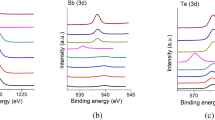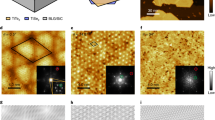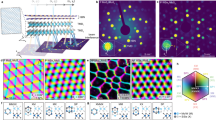Abstract
Moiré superlattices in transition metal dichalcogenide (TMD) heterostructures can host novel correlated quantum phenomena due to the interplay of narrow moiré flat bands and strong, long-range Coulomb interactions1,2,3,4,5,6,7,8,9. However, microscopic knowledge of the atomically reconstructed moiré superlattice and resulting flat bands is still lacking, which is critical for fundamental understanding and control of the correlated moiré phenomena. Here we quantitatively study the moiré flat bands in three-dimensional (3D) reconstructed WSe2/WS2 moiré superlattices by comparing scanning tunnelling spectroscopy (STS) of high-quality exfoliated TMD heterostructure devices with ab initio simulations of TMD moiré superlattices. A strong 3D buckling reconstruction accompanied by large in-plane strain redistribution is identified in our WSe2/WS2 moiré heterostructures. STS imaging demonstrates that this results in a remarkably narrow and highly localized K-point moiré flat band at the valence band edge of the heterostructure. A series of moiré flat bands are observed at different energies that exhibit varying degrees of localization. Our observations contradict previous simplified theoretical models but agree quantitatively with ab initio simulations that fully capture the 3D structural reconstruction. Our results reveal that the strain redistribution and 3D buckling in TMD heterostructures dominate the effective moiré potential and the corresponding moiré flat bands at the Brillouin zone K points.
This is a preview of subscription content, access via your institution
Access options
Access Nature and 54 other Nature Portfolio journals
Get Nature+, our best-value online-access subscription
$29.99 / 30 days
cancel any time
Subscribe to this journal
Receive 12 print issues and online access
$259.00 per year
only $21.58 per issue
Buy this article
- Purchase on Springer Link
- Instant access to full article PDF
Prices may be subject to local taxes which are calculated during checkout




Similar content being viewed by others
Data availability
The data supporting the findings of this study are included in the main text and in the Supplementary Information files, and are also available at https://github.com/HongyuanLiCMP/Moire_STM_source_data.
References
Tang, Y. et al. Simulation of Hubbard model physics in WSe2/WS2 moiré superlattices. Nature 579, 353–358 (2020).
Wu, F., Lovorn, T., Tutuc, E. & MacDonald, A. H. Hubbard model physics in transition metal dichalcogenide moiré bands. Phys. Rev. Lett. 121, 026402 (2018).
Shimazaki, Y. et al. Strongly correlated electrons and hybrid excitons in a moiré heterostructure. Nature 580, 472–477 (2020).
Regan, E. C. et al. Mott and generalized Wigner crystal states in WSe2/WS2 moiré superlattices. Nature 579, 359–363 (2020).
Wang, L. et al. Correlated electronic phases in twisted bilayer transition metal dichalcogenides. Nat. Mater. 19, 861–866 (2020).
Yankowitz, M. et al. Tuning superconductivity in twisted bilayer graphene. Science 363, 1059–1064 (2019).
Liu, X. et al. Tunable spin-polarized correlated states in twisted double bilayer graphene. Nature 583, 221–225 (2020).
Kim, K. et al. Tunable moiré bands and strong correlations in small-twist-angle bilayer graphene. Proc. Natl Acad. Sci. USA 114, 3364–3369 (2017).
Lu, X. et al. Superconductors, orbital magnets and correlated states in magic-angle bilayer graphene. Nature 574, 653–657 (2019).
Cao, Y. et al. Correlated insulator behaviour at half-filling in magic-angle graphene superlattices. Nature 556, 80–84 (2018).
Cao, Y. et al. Unconventional superconductivity in magic-angle graphene superlattices. Nature 556, 43–50 (2018).
Zondiner, U. et al. Cascade of phase transitions and Dirac revivals in magic-angle graphene. Nature 582, 203–208 (2020).
Burg, G. W. et al. Correlated insulating states in twisted double bilayer graphene. Phys. Rev. Lett. 123, 197702 (2019).
Cao, Y. et al. Tunable correlated states and spin-polarized phases in twisted bilayer–bilayer graphene. Nature 583, 215–220 (2020).
Chen, G. et al. Evidence of a gate-tunable Mott insulator in a trilayer graphene moiré superlattice. Nat. Phys. 15, 237–241 (2019).
Chen, G. et al. Tunable correlated Chern insulator and ferromagnetism in a moiré superlattice. Nature 579, 56–61 (2020).
Chen, G. et al. Signatures of tunable superconductivity in a trilayer graphene moiré superlattice. Nature 572, 215–219 (2019).
Slagle, K. & Fu, L. Charge transfer excitations, pair density waves, and superconductivity in moiré materials. Phys. Rev. B 102, 235423 (2020).
Zhang, Y., Yuan, N. F. & Fu, L. Moiré quantum chemistry: charge transfer in transition metal dichalcogenide superlattices. Phys. Rev. B 102, 201115 (2020).
Kerelsky, A. et al. Maximized electron interactions at the magic angle in twisted bilayer graphene. Nature 572, 95–100 (2019).
Xie, Y. et al. Spectroscopic signatures of many-body correlations in magic-angle twisted bilayer graphene. Nature 572, 101–105 (2019).
Jiang, Y. et al. Charge order and broken rotational symmetry in magic-angle twisted bilayer graphene. Nature 573, 91–95 (2019).
Choi, Y. et al. Electronic correlations in twisted bilayer graphene near the magic angle. Nat. Phys. 15, 1174–1180 (2019).
Pan, Y. et al. Quantum-confined electronic states arising from the moiré pattern of MoS2–WSe2 heterobilayers. Nano Lett. 18, 1849–1855 (2018).
Zhang, C. et al. Interlayer couplings, moiré patterns, and 2D electronic superlattices in MoS2/WSe2 hetero-bilayers. Sci. Adv. 3, e1601459 (2017).
Zhang, Z. et al. Flat bands in twisted bilayer transition metal dichalcogenides. Nat. Phys. 16, 1093–1096 (2020).
Raja, A. et al. Coulomb engineering of the bandgap and excitons in two-dimensional materials. Nat. Commun. 8, 15251 (2017).
Wang, G. et al. Colloquium: excitons in atomically thin transition metal dichalcogenides. Rev. Mod. Phys. 90, 021001 (2018).
Ugeda, M. M. et al. Giant bandgap renormalization and excitonic effects in a monolayer transition metal dichalcogenide semiconductor. Nat. Mater. 13, 1091–1095 (2014).
Waters, D. et al. Flat bands and mechanical deformation effects in the moiré superlattice of MoS2-WSe2 heterobilayers. ACS Nano 14, 7564–7573 (2020).
Acknowledgements
This work was supported by the Director, Office of Science, Office of Basic Energy Sciences, Materials Sciences and Engineering Division of the US Department of Energy under the van der Waals heterostructure program (KCWF16), contract number DE-AC02-05CH11231 (device electrode preparation, STM spectroscopy, DFT calculations and theoretical analysis). Support was also provided by the US Army Research Office under MURI award W911NF-17-1-0312 (device layer transfer), and by the National Science Foundation Awards DMR-1807233 (surface preparation) and DMR-1926004 (GW calculations). S.T. acknowledges support from DOE-SC0020653, NSF DMR 1552220, DMR 1904716 and NSF CMMI 1933214 for WSe2 and WS2 bulk crystal growth and analysis. K.W. and T.T. acknowledge support from the Elemental Strategy Initiative conducted by the MEXT, Japan, grant number JPMXP0112101001, JSPS KAKENHI grant number JP20H00354 and the CREST(JPMJCR15F3), JST for bulk hBN crystal growth and analysis. E.C.R. acknowledges support from the Department of Defense (DoD) through the National Defense Science & Engineering Graduate Fellowship (NDSEG) Program. S.L. acknowledges support from Kavli ENSI Heising Simons Junior Fellowship. M.H.N. thanks S. Kundu and M. Jain for their implementation of noncollinear wavefunction plotting in Siesta. Computational resources were provided by Cori at National Energy Research Scientific Computing Center (NERSC), which is supported by the Office of Science of the US Department of Energy under contract no. DE-AC02-05CH11231, Stampede2 at the Texas Advanced Computing Center (TACC) through Extreme Science and Engineering Discovery Environment (XSEDE), which is supported by National Science Foundation under grant no. ACI-1053575 and Frontera at TACC, which is supported by the National Science Foundation under grant no. OAC-1818253.
Author information
Authors and Affiliations
Contributions
M.F.C., F.W. and S.L. conceived the project, and S.G.L. supervised the theoretical calculations. H.L. and S.L. performed the STM measurements, and M.H.N. carried out the DFT and GW calculations. H.L., J.X., X.L., J.W., W.Z., S.Z. and S.K. fabricated the heterostructure device. E.R. and D.W. performed the second harmonic generation measurements. K.Y., M.B. and S.T. grew WSe2 and WS2 crystals. K.W. and T.T. grew the hBN single crystal. All authors discussed the results and wrote the manuscript.
Corresponding authors
Ethics declarations
Competing interests
The authors declare no competing interests.
Additional information
Peer review information Nature Materials thanks Andrea Young and the other, anonymous, reviewer(s) for their contribution to the peer review of this work.
Publisher’s note Springer Nature remains neutral with regard to jurisdictional claims in published maps and institutional affiliations.
Supplementary information
Supplementary Information
Materials and Methods and Supplementary Figs. 1–13.
Rights and permissions
About this article
Cite this article
Li, H., Li, S., Naik, M.H. et al. Imaging moiré flat bands in three-dimensional reconstructed WSe2/WS2 superlattices. Nat. Mater. 20, 945–950 (2021). https://doi.org/10.1038/s41563-021-00923-6
Received:
Accepted:
Published:
Issue Date:
DOI: https://doi.org/10.1038/s41563-021-00923-6
This article is cited by
-
Remote imprinting of moiré lattices
Nature Materials (2024)
-
Dynamically tunable moiré exciton Rydberg states in a monolayer semiconductor on twisted bilayer graphene
Nature Materials (2024)
-
Crystal net catalog of model flat band materials
npj Computational Materials (2024)
-
Engineering interlayer hybridization in van der Waals bilayers
Nature Reviews Materials (2024)
-
Imaging moiré excited states with photocurrent tunnelling microscopy
Nature Materials (2024)



